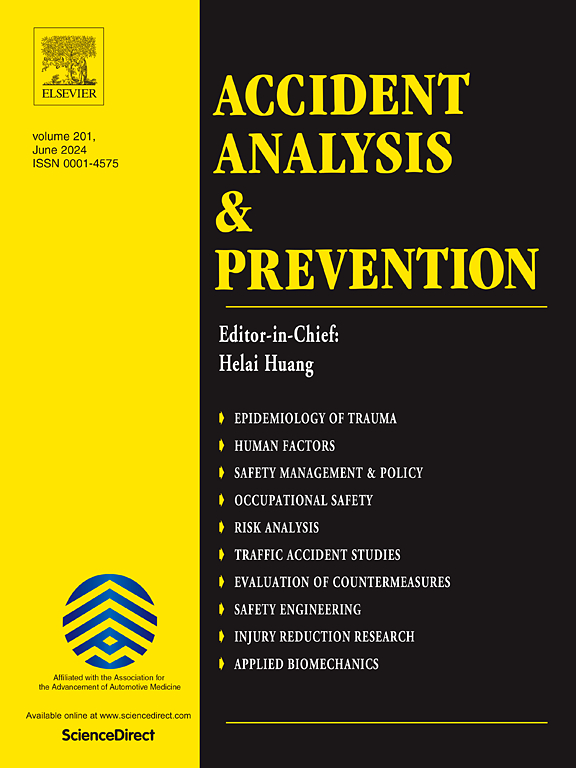碰撞频率建模中的段长度优化:安全性能评估中的功率谱段长度评估
IF 6.2
1区 工程技术
Q1 ERGONOMICS
引用次数: 0
摘要
选择合适的路段长度对道路安全分析至关重要,因为它直接影响到碰撞分析的准确性、危险位置的识别和安全性能的评价。传统的分割方法依赖于个人专业知识或工程判断,往往缺乏评估分割性能的标准化指标。因此,本研究扩展了基于空间频域分析(SFDA)的功率谱段长度(PSSL)在碰撞频率建模中的应用,以预测致命碰撞的发生。功率谱分析表明,碰撞频率主要集中在低频段,这有助于确定功率谱百分比(PSP),这是评估分割性能的关键指标。在考虑碰撞数据未观察到的异质性的情况下,针对6条农村双车道高速公路建立了随机参数负二项(RPNB)模型,以评估PSSL的有效性。研究结果表明,累积残差(CURE)图和拟合优度统计表明,基于pssl的分割方法始终优于传统的分割方法。此外,研究结果表明,路边服务区、人口密度、次要接入点和异质性交通特征是所有高速公路类型致命事故的最重要预测因素。因此,本研究为路段长度选择提供了一个优化的、数据驱动的、理论上合理的框架,从而提高了碰撞建模和道路评估的准确性、可靠性和可扩展性。本文章由计算机程序翻译,如有差异,请以英文原文为准。
Segment length optimization for crash frequency modelling: Evaluating power spectral segment length in safety performance assessment
Selecting an appropriate segment length is essential for road safety analysis, as it directly influences crash analysis accuracy, hazardous location identification, and safety performance evaluation. The traditional segmentation approaches rely on individual expertise or engineering judgment and often lack standardized metrics for evaluating segmentation performance. Therefore, this study expands the utilization of Spatial Frequency Domain Analysis (SFDA) based Power Spectral Segment Length (PSSL) in crash frequency modeling for predicting fatal crash occurrence. The power spectral analysis reveals that crash frequencies predominantly concentrate in low-frequency bands, which helps in determining the Power Spectral Percentage (PSP), a critical measure for evaluating segmentation performance. The Random Parameters Negative Binomial (RPNB) models are developed for six rural two-lane highways in order to evaluate the effectiveness of PSSL, accounting for unobserved heterogeneity in crash data. The study results indicate that PSSL-based segmentation consistently outperforms traditional segmentation methods, as demonstrated by Cumulative Residual (CURE) plots and Goodness-of-Fit statistics. Additionally, the study results show that roadside service areas, population density, minor access points, and heterogeneous traffic characteristics are the most significant predictors of fatal crashes across all highway types. Hence, this study provides an optimized, data-driven, and theoretically justified framework for segment length selection, which improves accuracy, reliability, and scalability in crash modeling and road assessment.
求助全文
通过发布文献求助,成功后即可免费获取论文全文。
去求助
来源期刊

Accident; analysis and prevention
Multiple-
CiteScore
11.90
自引率
16.90%
发文量
264
审稿时长
48 days
期刊介绍:
Accident Analysis & Prevention provides wide coverage of the general areas relating to accidental injury and damage, including the pre-injury and immediate post-injury phases. Published papers deal with medical, legal, economic, educational, behavioral, theoretical or empirical aspects of transportation accidents, as well as with accidents at other sites. Selected topics within the scope of the Journal may include: studies of human, environmental and vehicular factors influencing the occurrence, type and severity of accidents and injury; the design, implementation and evaluation of countermeasures; biomechanics of impact and human tolerance limits to injury; modelling and statistical analysis of accident data; policy, planning and decision-making in safety.
 求助内容:
求助内容: 应助结果提醒方式:
应助结果提醒方式:


